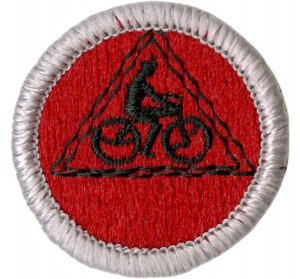If you’re an adventurous Scout who enjoys long rides and pushing your physical limits, the Cycling merit badge could be your ideal challenge. This badge helps you build practical skills in bicycle maintenance, road safety, and endurance riding. As one of the Eagle-required options for the fitness category (alongside Hiking and Swimming), Cycling gives Scouts the chance to explore their community on two wheels while developing discipline, focus, and resilience.
This badge is not just about racking up miles—it’s about learning how to ride safely, care for your equipment, and complete long-distance rides with confidence. Whether you’re on city streets or rugged trails, the skills you develop while earning this badge will stick with you for life.
Timeframe / Difficulty
The Cycling merit badge can take anywhere from 2 to 6 months to complete, depending on your starting fitness level, access to safe riding areas, and how often you train. Most Scouts find that the preparation and completion of the longer rides—especially the final 50-mile trip—require steady, ongoing effort.
This badge is moderate to difficult, with the main challenge being endurance. The technical and mechanical requirements are relatively straightforward, but the physical stamina needed for multiple long-distance rides makes this one of the tougher Eagle-required options.
Tips for Success
1. Create a weekly training plan.
Gradually build up to longer distances. Don’t jump from 10 to 25 miles in one weekend. Mix in rest days, and stretch after each ride.
2. Maintain your bike regularly.
A clean, well-tuned bike is safer and easier to ride. Practice adjusting your brakes, gears, and chain early in the process.
3. Track your rides.
Use a cycling app like Strava, Ride with GPS, or a paper log to record dates, distances, and routes. This will help with requirement tracking and writing your final report.
Complete Guide to the Cycling Merit Badge
This guide is only intended as a starting point for your research. Directly copying the information offered here is plagiarism. Doing your own research will allow you to get the most out of this badge and maintain the 12 points of the scout law. A scout is trustworthy!
Below is a full breakdown of the current requirements for the Cycling merit badge, followed by tips and explanations for each section.
Requirement 1
1. Do the following:
(a) Explain to your counselor the most likely hazards you may encounter while participating in cycling activities and what you should do to anticipate, help prevent, mitigate, and respond to these hazards. Explain to your counselor how to ride predictably, be conspicuous, think ahead, and ride ready.
(b) Show that you know first aid for injuries or illnesses that could occur while cycling, including cuts, scratches, concussions, blisters, sunburn, heat exhaustion, heatstroke, hypothermia, frostbite, dehydration, insect stings, tick bites, and snakebite. Explain to your counselor why you should be able to identify the poisonous plants and poisonous animals that are found in your area.
(c) Explain the importance of wearing the right clothing and gear while cycling, including a properly sized and fitted helmet. Know the BSA Bike Safety Guidelines.
Tips:
- For hazards, consider weather, poor lighting, road traffic, trail conditions, fatigue, and gear failure.
- Know how to treat injuries and illnesses related to exertion and exposure.
- Identify local poisonous plants and animals using a field guide or your Scout handbook.
- Demonstrate correct helmet fit (level on the head, straps snug, no side-to-side movement) and dress for both comfort and safety.
Requirement 2
2. Describe your state and local laws concerning bicycles. Discuss what is the same and what is different from laws applying to motor vehicles. Explain where and how you should ride on roads and streets to include lane position, changing lanes, making left and right turns, and riding through intersections.
Tips:
- Use your local department of transportation website or visit a bike shop for a printout of cycling laws.
- Focus on traffic laws that relate to lane usage, signals, and equipment like lights and reflectors.
- Practice hand signals and lane positioning on real roads with supervision.
Requirement 3
3. Explain the importance of wearing a properly sized and fitted helmet while cycling and of wearing the right clothing for the weather. Know the Scouting America Bike Safety Guidelines.
Tips:
- Dress in bright, moisture-wicking clothes for daytime rides. Layer for colder weather.
- Always wear a helmet that meets safety standards and fits snugly.
- Understand how different weather affects riding (heat, cold, rain, wind) and how to prepare accordingly.
Requirement 4
4. Using a bicycle safety checklist, clean and adjust a bicycle and present it to your counselor for inspection. Do the following:
(a) Show points that should be checked regularly to make sure the bicycle is safe to ride.
(b) Show how to adjust the saddle and handlebars for a proper fit.
(c) Show how to adjust brakes and gear shifting (derailleurs).
(d) Show all points that need regular lubrication.
(e) Show how to repair a flat by removing the tire, replacing or patching the tube, and remounting the tire.
(f) Show that the bicycle meets local laws.
Tips:
- Use the Park Tool maintenance guides for detailed tutorials.
- Make sure your chain is clean, tires are inflated, brakes are responsive, and your reflectors and lights are functional.
- Practice fixing flats at home until you can do it quickly and confidently.
Requirement 5
5. Demonstrate basic bicycle handling skills to your counselor, to include how to properly mount your bicycle, starting and stopping (to include emergency stops), riding in a straight line, turning, shifting gears, scanning, and signaling.
Tips:
- Practice in a quiet parking lot or bike path.
- Include scanning over your shoulder, using hand signals, and shifting smoothly.
- Emergency stops should be practiced on both paved and unpaved surfaces if possible.
- This graphic from ilovebiking.com gives a great overview of biking signaling.

Requirement 6
6. Using the Scouting America buddy system, complete all of the requirements for ONE of the following options: Road Biking OR Trail or Mixed Surface Biking.
Option A: Road Biking
(a) Take a road safety test with your counselor and demonstrate the following:
(1) On an urban street with light traffic, properly execute a left turn from the center of the street; also demonstrate an alternate left-turn technique used during periods of heavy traffic.
(2) Properly execute a right turn.
(3) Demonstrate appropriate actions at a right-turn-only lane when you are continuing straight.
(4) Show proper curbside and road-edge riding. Show how to ride safely along a row of parked cars.
(5) Cross railroad tracks properly.
(b) Avoiding main highways, take two rides of 10 miles each, two rides of 15 miles each, and two rides of 25 miles each. You must make a report of the rides taken. List dates for the routes traveled, and interesting things seen on the ride.
(c) After completing requirement b for the road biking option, do ONE of the following:
(1) Lay out on a road map a 50-mile trip. Stay away from main highways. Using your map, make this ride in eight hours or less.
(2) Participate in an organized bike tour of at least 50 miles. Make this ride in eight hours or less. Afterward, use the tour’s cue sheet to make a map of the ride.
Tips:
- Plan your rides in advance using Google Maps, Ride with GPS or Strava (my personal favorite).
- Record each ride in a logbook or app, including route, distance, weather, and observations.
- Practice safe navigation and signaling on real streets with adult supervision.
- For the 50-mile ride, bring water, snacks, a basic repair kit, and let someone know your route.
Option B: Trail or Mixed Surface Biking
(a) Demonstrate the following mountain bike handling skills to your counselor:
(1) Neutral position, ready position, bike body separation (side to side, and forward and back), and body positioning for cornering
(2) Show shifting skills as applicable to climbs and obstacles.
(3) Show proper technique for riding up (seated, crouched, and standing) and down hills.
(b) Take a trail safety test with your counselor and demonstrate the following:
(1) Show proper trail etiquette to hikers and other cyclists, including when to yield the right-of-way.
(2) Demonstrate how to correctly cross an obstacle by either going over the obstacle on your bike or dismounting your bike and crossing over or around the obstacle
(3) Cross rocks, gravel, and roots properly
(c) Describe the rules of trail riding, including how to know when a trail is unsuitable for riding.
(d) On mountain biking or multi-use trails approved by your counselor, take two rides of 2 miles each, two rides of 5 miles each, and two rides of 8 miles each. You must make a report of the rides taken. List dates for the routes traveled, and interesting things seen.
(e) After fulfilling the previous requirement, lay out on a trail map a 22-mile trip. You may include multiple trail systems, if needed. Stay away from main highways. Using your map, complete this ride in one day.
Tips:
- Practice mountain bike skills in a local park or single-track trail system.
- Learn how to scan ahead, shift for steep grades, and use your body to balance through obstacles.
- For longer rides, bring a trail map and plenty of water. Trail etiquette is key—yield to hikers and uphill riders.
Conclusion
The Cycling merit badge is one of the most exciting and physically rewarding options for Scouts working toward Eagle. Whether you complete your rides on pavement or dirt trails, this badge will challenge your stamina, build your mechanical confidence, and prepare you for a lifetime of safe cycling.
For official Cycling merit badge requirements, visit the Scouting.org Cycling page.
Now get out there, ride safe, and enjoy the journey. You’ve got this!





